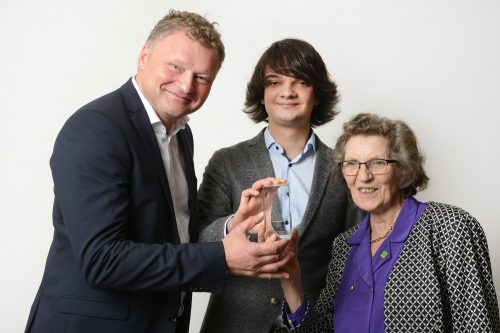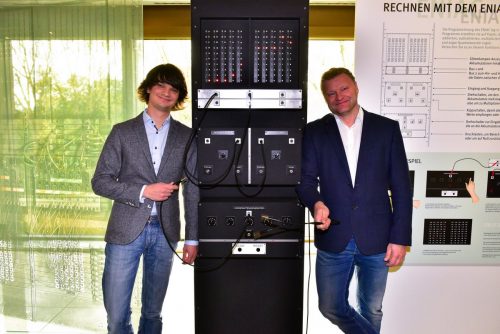Interactive 1950’s computer programming reconstruction from Germany wins 2016 Tony Sale Award
The 2016 Tony Sale Award for computer conservation has been won by the Heinz-Nixdorf MuseumsForum (HNF) for its evocative and educational reconstruction showing how ENIAC, one of the first electronic computers, was programmed. The Tony Sale Award, managed by the Computer Conservation Society and sponsored by Google, recognises achievements in the growing area of computer conservation.

Photo: Computer Conservation Society.
ENIAC was programmed by plugging wires and turning knobs, a physical skillset quite different from those deployed today. The reconstruction of part of the huge 1946 American computer has the look and feel of the original, but has been simplified to make it readily understood and even programmable by non-specialists.

Chair of the judging panel, Professor Martin Campbell-Kelly said, “The HNF reconstruction captured the essence of the landmark ENIAC computer. The panel was particularly impressed at the thought and planning that went into making the reconstruction accessible to non-specialist audiences. Then the execution of the ideas produced an artefact that is robust and ideal for a hands-on museum display to demonstrate the physicality of early computer programming. Modern audiences are bound to be surprised and captivated by the reconstruction.”
The inspiration for the reconstruction was the HNF’s Ada Lovelace bicentenary celebration – the ENIAC was originally mostly programmed by women. Operating six days a week in the museum, the reconstructed ENIAC accumulator (the ‘register’ in modern terminology) is safe and robust enough to be operated unsupervised by visitors.
Campbell-Kelly concluded, “The judging panel has been especially pleased at the sheer variety of entries we are receiving for the Tony Sale Award for computer conservation. The ENIAC reconstruction is quite different to our previous winners: Dr David Link’s computer art installation, LoveLetters; the IBM 1401 experience by the Computer History Museum; and the virtual reconstruction of the German 1930’s Z1 mechanical computer. With such diversity and global interest, the Tony Sale Award is providing a great benchmark for the developing science and art of computer conservation.”
Other entries shortlisted for the 2016 award included a restoration of a 1972 PDP-12 computer by the Rhode Island Computer Museum; the conservation of a 1980’s IBM 30684 computer in the Jim Austin collection in York, England; and the restoration of a 1960’s computer peripheral, an IBM 1403-N1 printer at the Computer History Museum in California.
Making IT Work, a meeting on the practice of computer conservation, will be held on 22-23 May 2017. The international meeting will be the first of its type and is organised by the Computer Conservation Society and The National Museum of Computing. Conference sessions with international speakers be on Monday 23 May at the BCS HQ in London and workshop sessions at The National Museum of Computing on Tuesday 24 May 2017. For details, see computerconservationsociety.org and tnmoc.org
The Computer Conservation Society
Established in 1989, the Computer Conservation Society (CCS) started as a joint venture between BCS, The Chartered Institute for IT, the Science Museum and later the Museum of Science and Industry in Manchester. In recent years, The National Museum of Computing has become a key partner.
The CCS Judging panel
Martin Campbell-Kelly, computer historian, was joined in the 2014 panel of judges by Chris Burton, engineer and computer conservationist, Nigel Sale, computer scientist and son of Tony Sale, and Doron Swade MBE, museum curator and author.
Tony Sale
Tony Sale (1931-2011), in whose honour the computer conservation award has been established, is perhaps best known for leading the team that rebuilt Colossus, the World War II code-breaking computer. He was also a key figure in starting the campaign to save Bletchley Park in the early 1990s, he co-founded The National Museum of Computing and jointly established the Computer Conservation Society.








